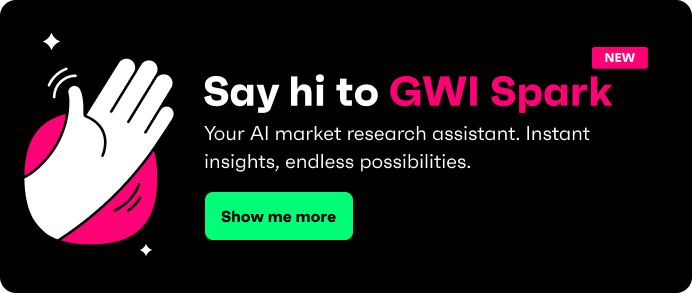
These days, maybe we’re better off expecting the unexpected.
Donald Trump made experts eat their forecasts by becoming America’s President a second time, the Reform Party did surprisingly well in recent UK local elections, and far-right groups all over the world are gaining some serious ground.
At the same time, messages around social and eco responsibility don’t land like they used to, and many brands are quietly scaling back their commitments.
The challenge for us was finding a single phrase to sum all this up.
What’s a vibe shift anyway?
We landed on “vibe shift”, a term that became popular in 2022 after forecaster Sean Monahan wrote an impactful piece on Substack.
Since then, it’s come to describe a gut-level feeling that attitudes are changing and that the progressive agenda is giving way to conservative ideas.
The question is: are consumer priorities really changing? If so, why? And how should brands respond?
More of us keep to ourselves
Some trends crash the party; others tiptoe in unnoticed, with the subtle ones often being the most powerful.
One of the most striking “quiet” trends we’ve seen in recent years is consumers becoming more inward-looking and self-contained. Fewer people are interested in other cultures, support for immigration has dropped, and community involvement has taken a back seat.

People are basically withdrawing and focusing more on their own needs, which is the blueprint for everything we’re about to unpack.
Young people are driving a political vibe shift
For starters, this shift lays the foundation for changing political attitudes. Young people, who will represent an increasingly bigger share of consumers as time goes on, are often thought to be more liberal – which is an idea that’s open to question.
In the past, people decided that Gen Z campaigners (like Swedish activist Greta Thunberg) were the voice of their generation, yet recent polls show that Sweden’s young people are just as likely to vote for the country’s far-right party. And US Gen Z, who usually get called “woke”, also got called “anti-woke” in the aftermath of 2024’s election.
To be fair, this generation prefers less loaded terms. Just 3% say the word “woke” best describes their political attitude, which makes these kinds of headlines problematic. But they’re not plucked from thin air either.
There’s been an ongoing rise in young Americans saying they’d vote Republican, a trend we can trace all the way back to 2020. The Democrats are still US Gen Z’s top choice, but the scales have really shifted.

Beyond that, the share of US Gen Z saying traditional gender roles are outdated dropped by 18% between 2020-2024, another sign that the progressive agenda is slipping.
Insights into today’s media landscape
So, why is this happening? Well, one factor is the breakdown of traditional influence. We’ve seen drops in engagement with news sites, and in time spent reading online press.
This likely had an influence on 2024’s election results, with more of us leaning on alternative outlets like independent creators, AI-generated summaries, and podcasts for insights.
In fact, there’s been a 52% rise in Americans listening to news and politics podcasts since 2020. And Trump on The Joe Rogan Experience rocketed to over 20 million views in just 20 hours.
Consumers might trust established media sources more than social platforms for news, but they’re struggling to keep people’s attention in a world where content discovery is algorithm-driven and spread across many platforms. Traditional gatekeepers no longer control the narrative.
Inflation is playing a big part
The next elephant in the room is inflation. Compared to 2020, far more Americans are worried about tax increases and saving for retirement, while concerns around climate change and racial relations have fallen.
It’s ultimately difficult for people to find the headspace to push for progressive political change when they’re anxious about paying next month’s bills, and various conservative parties have been better at signposting economic issues.
Social scientist Alice Evans has a theory that if young men are struggling financially, it triggers a kind of patriarchal backlash. They see their male role models as breadwinners and don’t feel they match up, which helps explain why traditional gender roles are more attractive right now.
All consumers have their limits
Simply put, people are tired. It’s possible societies have been overexposed to progressive messaging and are now wary of brands pushing it. Activism has been commodified and turned into a “comms strategy” in some cases, and consumers aren’t buying it anymore.
Meanwhile, the world isn’t as stable as it used to be. Global risk indicators show that we have much less recovery time between “once-in-a-generation” events, and these crises constantly appear in the social feeds where we all interact.
And we can see this sense of fatigue, doubt, and financial anxiety being played out in people’s brand expectations.
We want it marked down
As concerns around finances and skepticism toward values-based marketing have grown, consumers have become more pragmatic and less bothered about bonding with brands.
Pay-to-use services with lower upfront costs have become more attractive, while fewer people are willing to pay a premium for sustainability.

Eco concerns aren't gone, but they’re cooling off. Often seen as a “luxury problem”, many of us expect governments and brands to shoulder the cost. So, sustainability messaging shouldn’t just be about “doing the right thing”. It needs to spell out what’s in it for consumers - whether that’s saving money, time, or getting freebies.
People want both free speech and online safety
Expectations have also changed alongside media habits, and in response to platform changes. Meta and X have both taken a leaf from Reddit’s book by replacing fact-checkers with community notes.
And reactions to this, like attitudes toward content moderation, are mixed and inconsistent. While over 3 in 5 people say free speech on social media is very or extremely important, around half also agree that these sites should be able to control the content users see, which is a seemingly contradictory outlook that experts call “the moderation paradox”.
So, there's a need to balance safety with openness. Some of us prioritize unrestricted discussions, others focus more on protection from misinformation. Many want both.
Where will the vibe shift go?
Of course, no one has a crystal ball, but we can lean on past patterns to make reasonable predictions about what might happen next.
On the political side of things, we may be at or near the peak of this vibe shift. There’s a concept called the thermostatic model of public opinion, where societies go against whatever politicians do in power. If the public feel politicians are being too conservative, they ask for more liberal policies, and vice versa.
And there are nods to this everywhere. Presidents’ approval ratings tend to drop after they get voted in, and Joe Rogan’s top spot was recently nabbed by an anti-Trump podcast.
What’s more, far-right parties usually see an uptick in vote share just after a financial crisis. So, left-wing parties could become more attractive when or if the economy improves - especially when we consider that young people are more issue-based when it comes to voting, and less loyal to political parties in general.
On the other hand, consumer efforts to make practical choices while shopping have been ongoing and are likely to stick around.
What should brands take away from the vibe shift?
As party lines are particularly blurred right now, businesses should focus on what different groups have in common, rather than leading with purpose-driven messages that risk polarizing people. For example, Democrat and Republican voters are equally likely to want companies to be honest and to care strongly about children's welfare causes. This may be even more important for brands that they use in equal measures, like McDonald's or Best Buy.
It’s also worth being cautious about linking behavioral changes to the vibe shift. More Americans have given up vegan diets, but oat milk has been a real growth market. And while people are more conservative about gender, the WNBA is one of the fastest-growing US sports leagues.
Next, as the social media moderation goalposts shift, brands may want to tweak their communication style. It may be beneficial for them to open up conversations around customer community guidelines and let members shape them, rather than censoring opinions based on gut feeling. They should aim to use trusted sources in their posts or replies, and could team up with influencers who debunk rumors and ease tensions.
Finally, people are generally more transactional right now, likely due to concerns around inflation. We wouldn’t recommend stopping all your sustainability or social efforts, but it’s not worth making them the focal point of your campaigns. Consumers care more about the value you’re bringing to their lives, and will for the foreseeable future.





.webp?width=495&height=317&name=pink_thumb_graphs%20(1).webp)
.webp?width=495&height=317&name=pink_thumb_letter%20(2).webp)